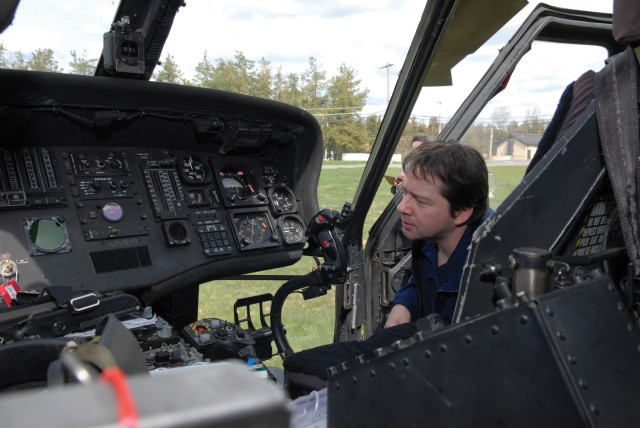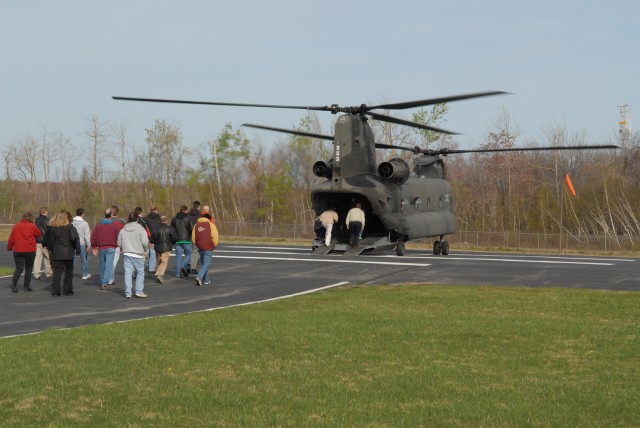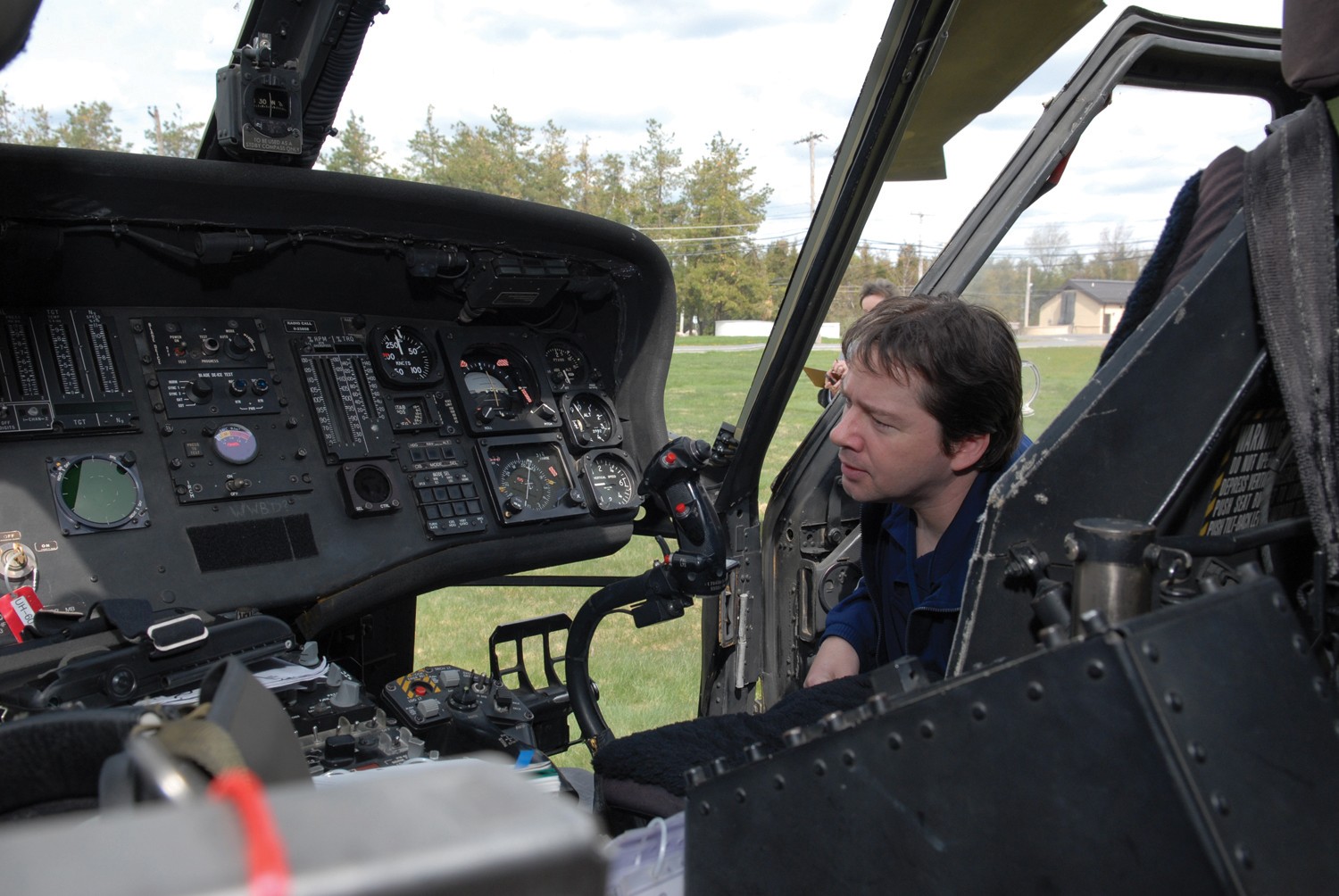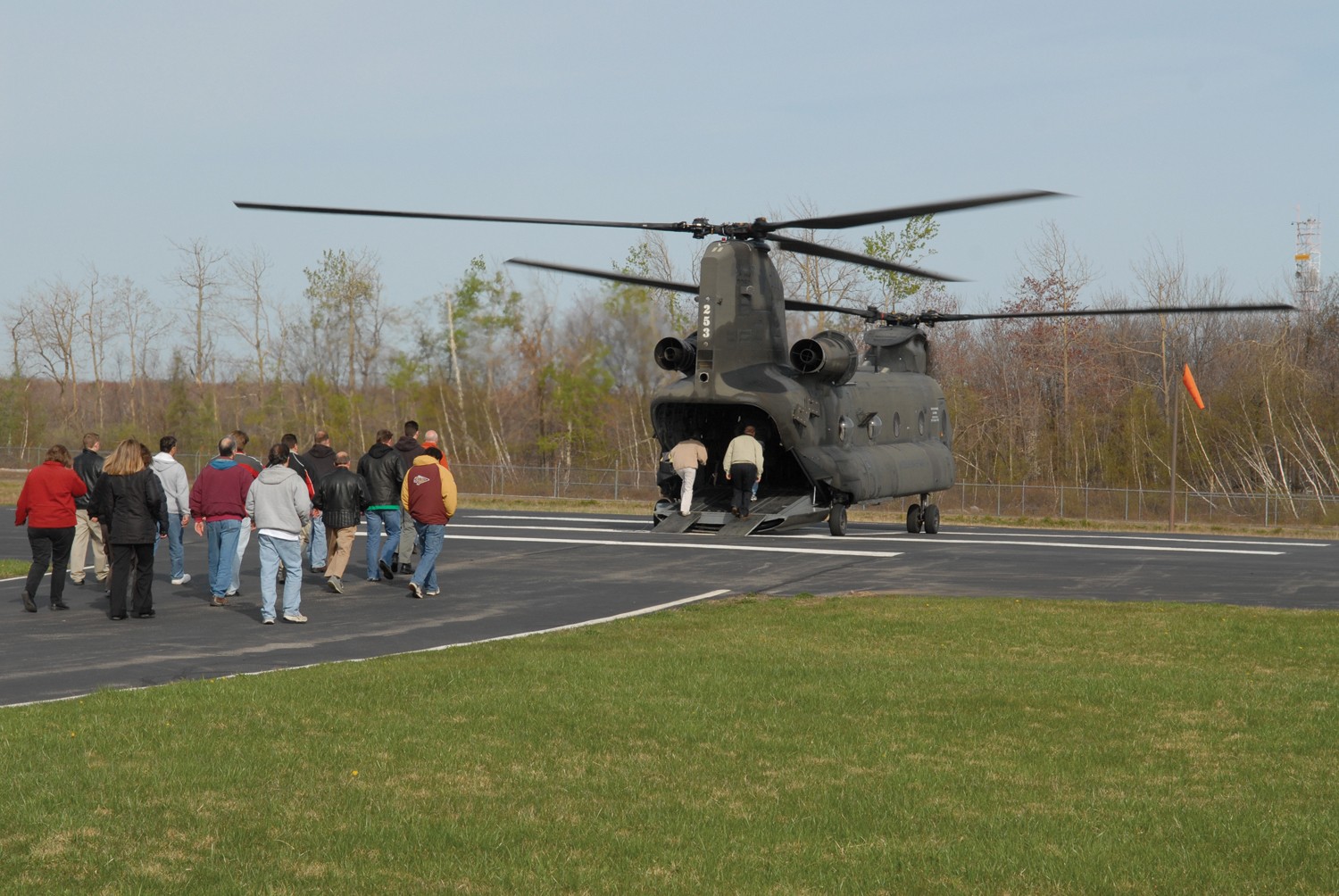TOBYHANNA ARMY DEPOT, PA. - Army aviators met with the men and women who repair avionics systems in the UH-60 Black Hawk and CH-47 Chinook during a familiarization training day at Tobyhanna.
Hundreds of avionics technicians toured two static display helicopters and talked to crew members about how their job impacts the warfighter.
As part of the day's events, Tobyhanna hosted the first Region 5 of the Mid-Atlantic Chapter of the Army Aviation Association of America luncheon.
"Thank you from the viewpoint of one of those aviators in the aircraft," said guest speaker Col. John Gallagher, 244th Combat Aviation Brigade commander, Fort Dix, N.J. "We appreciate what you do for us every day. You're work allows us to do our job."
Michael Edwards flew in several types of aircraft while deployed to Iraq, but admitted that this experience was different. Seeing the equipment mounted in the aircraft helped him realize how important it is to perform his job to the best of his ability.
"I knew Tobyhanna worked on equipment that I used when I was deployed; but to work on that same equipment and see it being used puts what you do into perspective," he said. "The experience opened my eyes to not only how important my job is, but everything we do here."
Capt. Trevor Patrick piloted the Chinook onto a field near The Landing. He and flight engineer Staff Sgt. Travis Goebel welcomed visitors and explained how different avionics systems work on the helicopter. Patrick is the company commander for Bravo Company 2-104, 28th Combat Aviation Brigade, Fort Indiantown Gap. The unit and aircraft recently returned from a 12-month deployment in Iraq.
"It's great to meet the people who make it all happen," Patrick said shaking hands with William and Mark Staples, electronics mechanics in the Navigation Systems Branch. Once the captain learned William overhauled and repaired the AN/ARN-147 VOR/ILS Radio Receiving Set, he described how the system is used to navigate. Mark works on the miniature airborne GPS receiver and the AN/ARN-89 Direction Finder Set.
The Black Hawk, piloted by Col. David Carey, set down near the Chinook. Carey is the 29th Combat Aviation Brigade commander, and commander of the Army Aviation Support Facility, Weide Army Airfield in Edgewood, Md. Crew chief Sgt. Alain Hawley was on hand to answer questions.
"Today, they'll [Tobyhanna employees] get to see the practical application of their work," Hawley said. "I hope seeing the aircraft reinforces their desire to do a good job."
The groups of employees milling around the helicopters seemed excited and curious about how their work affects the Soldiers and their mission.
Electronics Worker Darrin Sheare wanted to know where the communications instrument processor was located on the Black Hawk.
"I change microprocessor chips, make sure the right capacitor is in the equipment, change switches when necessary and make sure the component meets test requirements."
Another employee repairs the mode select switch panel, which is used in the Black Hawk helicopter.
"Having the opportunity to fly in one of our country's sophisticated aircraft was truly a unique experience," said Michael Grunza, electronics mechanic. "Not only was the flight fun and exciting, but I was able to see how the equipment I repair in the shop is used on the aircraft."
The event was dubbed a success by people who attended the day's activities, according to George Bellas, director of the Command, Control and Computer (C3)/Avionics Directorate. Bellas noted that feedback from the technicians indicated the event helped them understand where the items were located on the aircraft and how they work to support the aircrew.
"From our perspective, it was a tremendous success," said Wade Johnson, event coordinator. "The greatest gain for Tobyhanna is the opportunity for technicians to see how their work is integrated into the work that the warfighter is doing.' Johnson is a logistics management specialist in the Business Management Directorate.
"This was a huge morale builder,' said Joe Wassell, Avionics Division chief and event co-cordinator. "Everyone says you're important to the warfighter, but to hear it from a crew member . . . "
SCEP student Tiffany Lancia said she wants to learn the theory and application of electronics repair. The training opportunities and hands-on experience offered by the depot have helped her hone her skills. Lancia works in the Flight Control Systems Branch.
"The chance to sit in the Black Hawk opened my eyes to the extreme importance of the work I perform at the depot," Lancia said. "I now have a better understanding of the work we do at Tobyhanna."
Tobyhanna Army Depot is the Defense Department's largest center for the repair, overhaul and fabrication of a wide variety of electronics systems and components, from tactical field radios to the ground terminals for the defense satellite communications network. Tobyhanna's missions support all branches of the Armed Forces.
About 5,600 personnel are employed at Tobyhanna, which is located in the Pocono Mountains of northeastern Pennsylvania.
Tobyhanna Army Depot is part of the U.S. Army CECOM Life Cycle Management Command. Headquartered at Fort Monmouth, N.J., the command's mission is to research, develop, acquire, field and sustain communications, command, control computer, intelligence, electronic warfare and sensors capabilities for the Armed Forces.




Social Sharing